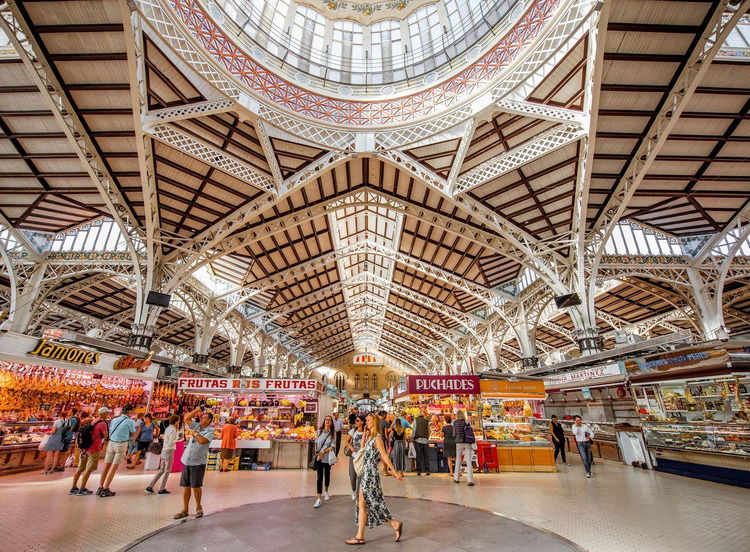
Spain is not only a country with magnificent beaches and a rich history, but also a real paradise for foodies. At every turn you can find traditional markets where locals and us tourists can enjoy fresh produce, unique delicacies and the atmosphere of real Spanish life. Of course, there are markets in Spain in every city, and even in every neighbourhood, if the city is big enough. But we will look at the most famous markets in Spain, their peculiarities and what makes them unique.
1. Mercado de San Miguel in Madrid
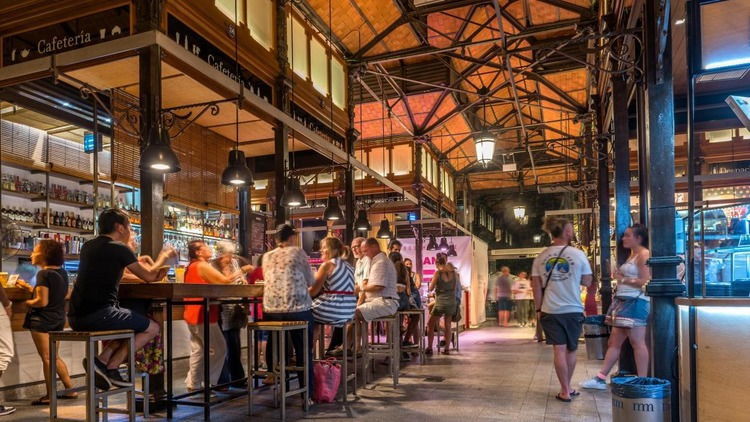 Among the great variety of markets in Spain, the San Miguel Market in Madrid certainly deserves the closest attention. Located in the historic centre of the capital, this market combines elements of a traditional Spanish market with a modern gastronomic space.
Among the great variety of markets in Spain, the San Miguel Market in Madrid certainly deserves the closest attention. Located in the historic centre of the capital, this market combines elements of a traditional Spanish market with a modern gastronomic space.
The Mercado San Miguel was opened to the public over 100 years ago and has since become an integral part of Madrid's culture. It's not very large, but it's extremely atmospheric - a spacious covered area with high glass ceilings creates a cosy environment for socialising and enjoying gastronomic delights. Here you can find just over 30 stalls, each offering its own unique delicacies. A distinctive feature of this market is the opportunity to sample various dishes and drinks without stepping outside.
The market is open daily, without weekends and this makes it a popular place for locals and tourists alike. Although, tourists seem to be much more numerous here - after all, it is the most famous market not only in Madrid, but in the whole of Spain. Every person who has come to see the capital city at least once is sure to stop by here and draw their own surprising conclusions.
2. Mercat de Sant Josep de la Boqueria in Barcelona
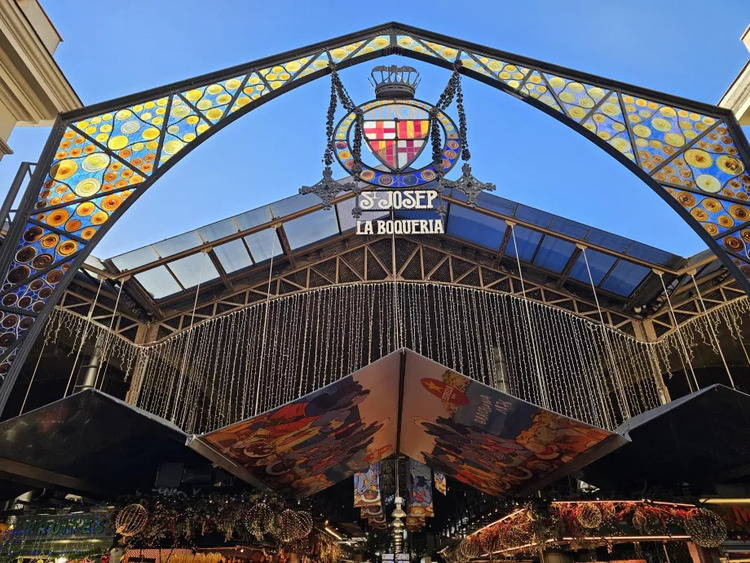 Boqueria is one of the most famous markets in Europe and a significant part of the Barcelona gastronomic culture. Located on the famous La Rambla boulevard, the Boqueria Market is widely regarded as a landmark in Spain.
Boqueria is one of the most famous markets in Europe and a significant part of the Barcelona gastronomic culture. Located on the famous La Rambla boulevard, the Boqueria Market is widely regarded as a landmark in Spain.
It was opened in 1840 under the name ‘San Josep Market’, but the building itself only took its present form by 1916 - it took too long to complete the roof.
One of the main features of Boquería are the colourful displays of fruit, vegetables, seafood and meat products. Each stall offers carefully selected products, many of which are locally sourced.
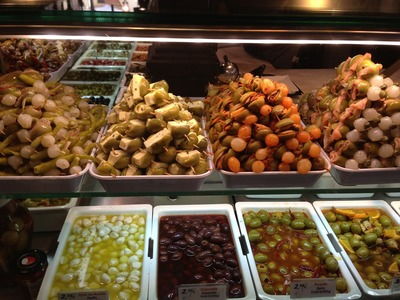
The market is also home to many cafés and eateries where you can enjoy traditional Spanish dishes such as paella, fried squid rings, tapas and much more. The Boqueria is not only an area for shopping, but also an ideal place to stay and enjoy the atmosphere of Barcelona. There are always a lot of people here, which adds to the popularity of this market.
Boqueria is also known for its masterclasses and gastronomic events, which are held regularly. Here you can not only taste a variety of dishes, but also learn how to cook Spanish specialities, which will make your visit even more exciting.
3. Mercado Central in Valencia
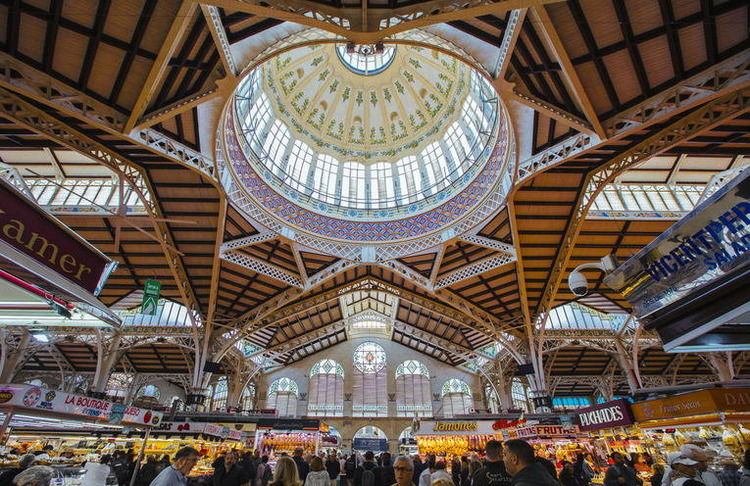 The Central Market in Valencia is one of the largest buildings in Spain, operating since the early 20th century. This magnificent Art Nouveau building has become a true icon of the city, and a visit to it is a must for all tourists who come to see the sights of Valencia.
The Central Market in Valencia is one of the largest buildings in Spain, operating since the early 20th century. This magnificent Art Nouveau building has become a true icon of the city, and a visit to it is a must for all tourists who come to see the sights of Valencia.
Mercado Central has over 200 stalls selling all kinds of fresh produce. The emphasis here is on quality and local production. You can find unique varieties of oranges for which the Valencia region is famous, as well as the freshest seafood, as the city is located on the Mediterranean coast. Also, on Mondays, there is a street market around Valencia's Central Market, where local farmers bring fruit and vegetables straight from the garden!
In addition to groceries, Mercado Central offers many cafes and eateries serving freshly brewed coffee, pastries and local specialities.
4. Mercado de Atarazanas in Malaga
 An equally interesting market can be found in Málaga - Mercado de Atarazanas. This market was opened in 1879 and is a combination of a traditional Spanish market and modern gastronomic trends. Its architecture and interior are striking in their unusual beauty.
An equally interesting market can be found in Málaga - Mercado de Atarazanas. This market was opened in 1879 and is a combination of a traditional Spanish market and modern gastronomic trends. Its architecture and interior are striking in their unusual beauty.
Atarazanas Market offers a variety of products including fresh fish, seafood and local rarities. Málaga is renowned for its excellent quality fish, and you're sure to find many types of fish, fresh shellfish and prawns here.
The Mercado de Atarazanas also offers local specialities that are an integral part of Andalusian cuisine. The most common are the ‘espeto de sardinas’ and the ‘pescadito frito’, usually small fried fish that the locals love. There are also real works of culinary art - sandwiches and tapas, selected using local produce.
5. Mercado de Triana in Sevilla
 The Triana Market in Sevilla is a picturesque place, ideal for travellers wishing to immerse themselves in the traditional atmosphere of a Spanish market. It is located very close to the Guadalquivir River and is famous for its bright colours and the variety of products on offer.
The Triana Market in Sevilla is a picturesque place, ideal for travellers wishing to immerse themselves in the traditional atmosphere of a Spanish market. It is located very close to the Guadalquivir River and is famous for its bright colours and the variety of products on offer.
One of the features of the Triana market is its historical significance. This market has been in existence since 1830 and still maintains its traditions. Here you will find fresh vegetables, fruit, meat and fish, as well as unique local products.
Locals often come to the market not only to shop but also to socialise with others, so the atmosphere is particularly warm and friendly. The market also has many eateries that prepare dishes made from the market's fresh produce. When you visit Triana Market, you can savour Seville's cuisine and try many traditional dishes.
6. Flea market in Madrid - El Rastro
 Rastro de Madrid is a famous flea market in Spain that is definitely worth a visit. This is a street market. It is located in the La Latina neighbourhood and is open every Sunday and public holidays from 9:00 to 15:00. There are over 1,000 stalls where you can find antiques, vintage items, clothes, books, vinyls and even furniture.
Rastro de Madrid is a famous flea market in Spain that is definitely worth a visit. This is a street market. It is located in the La Latina neighbourhood and is open every Sunday and public holidays from 9:00 to 15:00. There are over 1,000 stalls where you can find antiques, vintage items, clothes, books, vinyls and even furniture.
There are also unique finds waiting for you in the neighbourhood antique shops. This market offers an authentic crowded Madrid atmosphere and is great for locals and tourists alike.
Each of these markets is not just a place to shop, but also an opportunity to gain a deeper understanding of Spain's culture and gastronomic traditions. Whether you are in Madrid, Barcelona or any other city, a visit to a market is a must on your trip.

 English
English  Español
Español  Русский
Русский